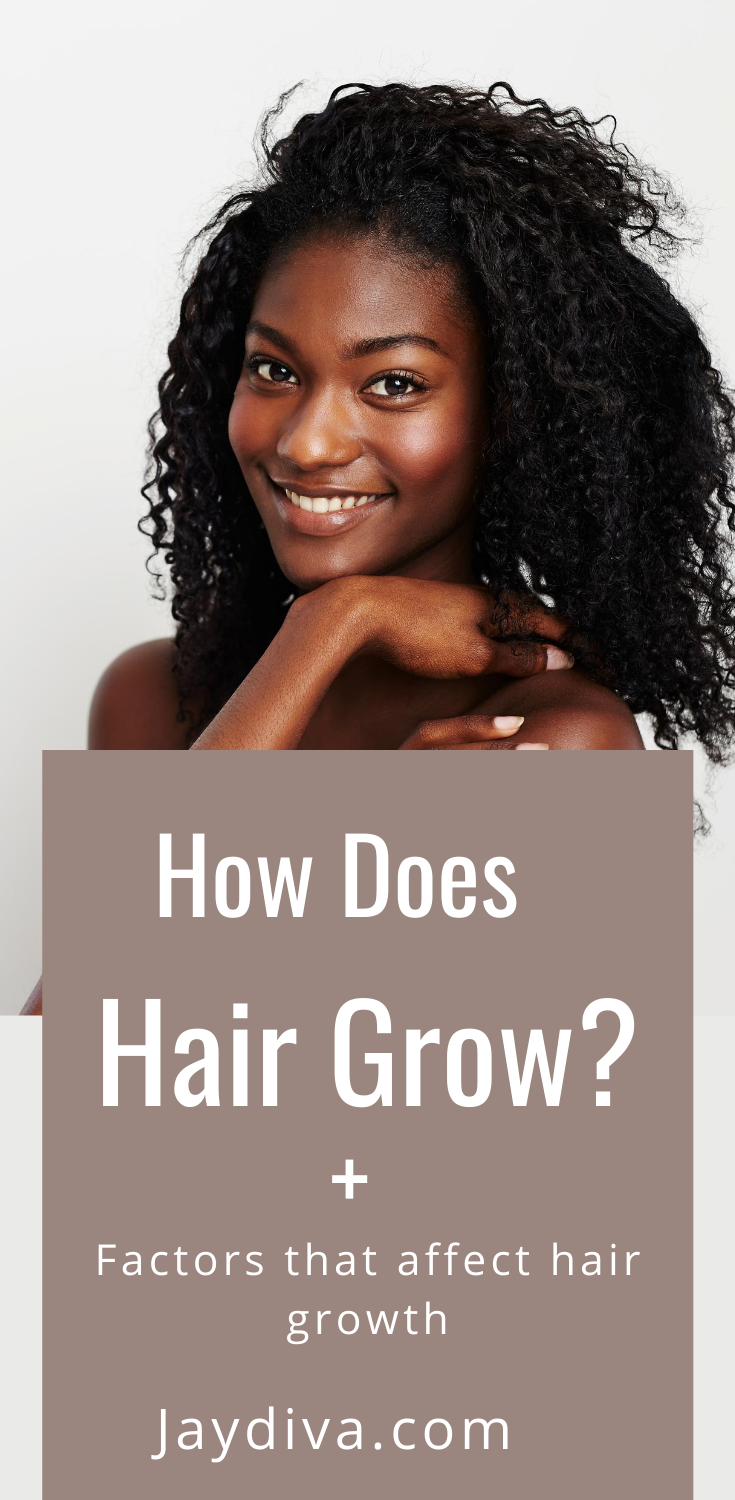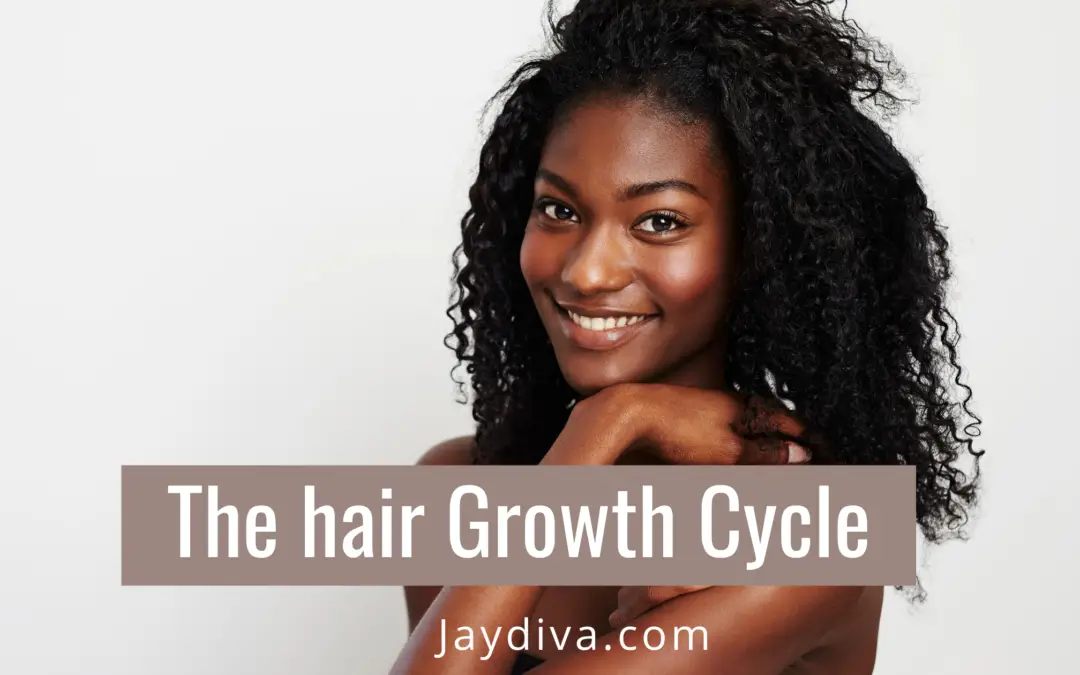Understanding the science of hair growth is important if you want to take better care of your hair and grow your hair healthy and optimize your hair growth potential. Read on to understand how hair grows, the hair growth cycle, and factors that determine and affect hair growth rate.
Pin for Later!

Table of Contents
The Human Hair Structure
To have a better understanding of how fast human hair grows and the hair growth cycle lets look at the hair structure.
The human hair is made up of structural proteins called keratin.
The hair is made up of two parts:
- The Hair Follicle
- The Hair Shaft
The Hair Follicle
The hair follicle is the part of the hair located in the dermal layer of the skin. It anchors the hair to the skin.
It is made up of two parts:
The dermal Papilla: This part contains blood vessels that supply the hair with oxygen and nutrients.
The Bulb: This layer contains actively dividing cells which are involved in the growth phase
The Hair Shaft
This is the part of the hair above the scalp
The shaft is comprised of three layers :
The Medulla: This is the innermost layer of the hair shaft. it not always present, only present in thick coarse hair. it contains a soft amorphous substance which functions as the marrow of the hair
The Cortex: This is the middle layer of the hair and forms the bulk of the hair about 90%. It contains keratin which is a structural protein and melanin which gives the hair its natural color.
The Cuticle: This is the outermost layer of the hair shaft. It is made of flattened cells arranged in a scale-like manner and this layer serves as a protective layer from external factors.
Related Post: Hair Porosity- All you need to know
Watch the video here
The Hair Growth Rate
The human hair growth rate varies from individual to individual however, we grow an average of about 0.5inch per month with is about 6 inches of hair per year.
Factors that Affect Hair Growth Rate
#1 Genetics
The hair growth rate is largely dependent on genetics. the genes determine your hair type, thickness, and length of the growth phase.
#2 Stress
Stress has an adverse impact on the health of the hair. At any given time about 10% of the hair is in its resting phase. Stress drives more hair into the resting phase and eventually leading to a condition called Telogen Effluvium where there is excessive shedding.
#3 Diet
A balanced diet is needed for a general well being. good nutrition impacts the health of the hair. eat fruits and vegetables. Foods rich in protein, iron, biotin, and zinc are essential for healthy hair growth. Consider a multivitamin supplementation after your doctor’s approval.
#4 Trauma to Hair Follicles
Repeated trauma to the hair follicles like with regular tight hairstyles that pull too much traction on the scalp could lead to a condition called traction alopecia. Another way the hair follicles can be damaged can be by the use of harsh chemical treatments.
#5 Medications
Most medications have side effects, and while some are mild, others can be severe. Medications used in chemotherapy have been known to cause hair loss. chemotherapeutic agents cause hair loss by affecting actively dividing cells in the anagen phase. The anagen phase which usually lasts about 2 to 6 years is usually shortened by these medications causing a lot of hair follicles to go into the telogen phase prematurely eventually leading to excessive hair loss. Usually, this hair loss is temporary and the normal hair growth rate returns a few months after discontinuing the medications.
#6 Pregnancy
In pregnancy, many women experience minimal shedding, thick and shiny long hair. An increase in estrogen levels is responsible for this. Estrogen causes more hair follicles to remain in the anagen phase which is the growing phase of the hair growth cycle. However, this growth is temporary. After birth, when the estrogen level drops, these hair follicles are pushed into the resting phase. which a lot of women experience as excessive shedding that occurs 3 to 6 months after childbirth.
The Hair Growth Cycle
We are born with a fixed amount of hair follicles at birth which averages about 100,000 hair follicles.
The hair grows in a cycle and each strand of hair is in its own growth cycle independent of the surrounding hairs
There are four phases in the hair growth cycle
- Anagen
- Catagen
- Telogen
- Exogen
The Anagen Phase (Growing Phase)
This is the first phase of the growth cycle. About 80-90% of the hairs at any given time are in this phase. This is known as the growing phase and it usually lasts about 2-6 years. The duration of this stage is determined by genetics. During this stage of the hair growth cycle, the cells in the bulb are actively dividing and receiving nourishment from the dermal papillae
The Catagen Phase (Transition Phase)
This is the second stage of the hair growth cycle and lasts 2-3 weeks. This is the transition stage. During this time, the hair follicle shrinks and detaches from its blood supply in the dermal papilla. The hair at this point is known as a club hair At any given time, about 1% of hair is in this stage.
The Telogen Phase (Resting Phase)
This is the third stage of the hair growth cycle, this phase lasts about 1-3 months. At this stage, the hair is dormant but receives nourishment from the epidermal cells lining the hair follicle. About 10-15% of the hair at any given time is in this phase
The Exogen Phase (Shedding Phase)
This ideally is a part of the telogen phase. This is when the hair sheds after being dormant. At this point, the hair falls off and this accounts for the 50-100 shed hairs we experience daily.
How To Increase Hair Growth Rate
Inasmuch as the hair growth a largely dependent on genetics there are a couple of healthy hair practices and lifestyle modifications that can encourage healthy hair growth.
#1 Balance Diet
Eating a healthy balanced meal can do a lot of good for your overall well being. from improving your immune system down to giving you glowing skin and healthy shiny hair growth. Eat fruits and vegetables regularly will improve your hair growth over time.
#2 Biotin
Biotin is a B Vitamin. It is involved in the metabolism of carbohydrates, fats, and amino acids into energy. Its deficiency though rare has been associated with hair loss and brittle nails. You can each biotin-rich foods like eggs, nuts, and mushrooms or take a biotin supplement to boost your hair health.
#3 Omega-3 fatty Acids
These are essential fats that are known for their ability to improve cardiovascular and mental health. Omega 3 fatty acids nourish the hair follicles keeping it moisturized and preventing dry and flaky scalp.
#4 Essential Oils
Essential oils have been known for ages to stimulate thicker hair growth. Oils like rosemary, peppermint, lavender, thyme, tea tree, and cedarwood are a few essential oils that promote hair growth. Essential oils increase hair growth by increasing circulation to the scalp which nourishes the hair follicles and promotes faster and thicker hair growth.
#5 Healthy Haircare Routine
A healthy hair care routine is important in your hair care journey. A simple hair care regimen will keep your hair strong and moisturize preventing dryness and breakage.
- Moisturize your ends with a water-based moisturizer to prevent breakage
- keep your hair in a simple low manipulation style
- Shampoo your hair with a mild sulfate-free cleanser
- Deep conditioner to give deep nourishment to your hair
- Avoid excessive heat styling, ensure to use a heat protectant when heat styling
- Trim your ends when needed to prevent split ends from ascending the hair shaft and causing breakage.
Conclusion
Understanding how hair grows and factors that could affect your hair growth is important. This will help you set realistic goals when you are on a journey to growing your hair long. This notwithstanding, you can achieve the hair of your dream by staying healthy and incorporating some good hair practices.
Pin for later!



























I eabt To start growing my hair and I want It to be healthy. I asked Abeautician for advice and she told me to drink water. 🤷🏽♀️So this information was very informative.